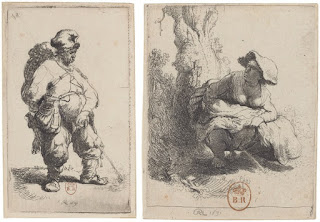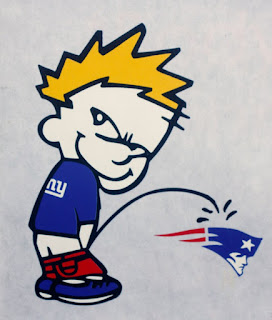A Secret History of the Pissing Figure in Art
September 20, 2017
François Boucher, "La Femme Qui Pisse ou L'Œil Indiscret," c. 1742–1765.
Courtesy David Zwirner Books
Look at "Saint Luke Drawing the Virgin," a fifteenth-century portrait by Rogier van der Weyden, and you'll notice two figures in the middle distance, lingering at the crenellations in the courtyard. One gestures in faint surprise; somebody has captured their attention. It's not Luke the Evangelist, the Virgin Mother, or even the infant Christ. It's a faraway man who has stopped to piss on a high wall.
This isn't an isolated incident. The fact is, a river of piss runs through art history. For centuries, painters and sculptors have depicted the act of urination. Men piss. Women piss. Most of all, young boys piss, so much so that scholars assigned a Latin term, puer mingens, to their ubiquitous appearances. Now Jean-Claude Lebensztejn, a French critic, has written "Pissing Figures, 1280–2014," a genealogy of the pisseurs and pisseuses who haunt our canvases, fountains, and frescoes. The book, in a rangy, fluent translation from Jeff Nagy, is a record of what Lebensztejn calls our "diuretic fantasies"—of the lore and lust surrounding urine, sacred and profane.
Lorenzo Lotto, "Venus and Cupid," 1525.
Metropolitan Museum of Art, New York. Courtesy David Zwirner Books
In the beginning was the pissing boy, the putto. He appeared first in the margins of illuminated manuscripts, peeing discreetly as if in fear of detection: the gentle plash, the flaxen strands as wispy as a maiden's hair. By the fifteenth century, he'd grown brazen and begun to multiply—"processions of urinating children set about inundating paintings and sculptures in villas and public squares," Lebensztejn writes. They pissed into vases and basins and shells and conchs, onto snowdrifts and poppy husks and flocks of cupids. They pissed in the mouths and anuses of other boys, who themselves pissed in more mouths still. These were no ordinary boys. Spritely and seraphic, often winged and laurelled, they charmed their way into old churches, where they patrolled the transepts and friezes, pure of heart and full of bladder. In Padua's Ovetari Chapel, for example, Andrea Mantegna painted a cycle of frescoes that included a pissing putto suspended from a garland, where, according to Lebensztejn, he "lets loose a long jet of urine, as if it were a bemused, symbolic paraphrase of the baptismal water."
Indeed, a boy's piss seems at some point to have crossed streams with holy water, becoming blessed with ablutionary powers. In Italy, Lebensztejn notes, "it is still customary, even today, to call an infant's intemperate pee acqua santa." Sometimes the gift of pure piss transferred to adulthood, though it helped if you were aiming heavenward. A thirteenth-century fresco in the Basilica of Saint Francis of Assisi shows three angels, grown men, holding their penises over Christ on the cross, as if they might relieve his suffering by relieving themselves.
Left: Rembrandt, "Pissing Man," 1631. Right: "Pissing Woman," 1631.
Of course, the angels, being angels, feel no relief as they piss. They get their celestial jollies by raining a little holy water on us, but they know nothing of urination as a physical urge. If you want to enjoy some real salt-of-the-earth pissing, Lebensztejn reports, you have to skip ahead to 1600. It was then that, with the advent of genre painting, and its attendant embrace of everyday experience over iconography, more and more adults began to piss in images. In Rembrandt's "Pissing Man" and "Pissing Woman," both from 1631, we've at last found a couple urinating without ceremony, the peasant woman "turning around to reassure herself that no one is watching."
In other drawings and paintings of the era, common people, dressed up or down, began to piss from brothels, gardens, and saddles, into the air and onto their own shadows. It was a great time to piss in art. Women began to do so in record numbers. Yes, they'd peed a bit earlier—you can spy one awhizz in the bottom-left corner of Matthias Gerung's "Melancholia," from 1558, kneeling as if abashed, with some guy puking beside her—but whereas in the past she'd retained "an allegorical aspect, mythological or animalistic," Lebensztejn writes, she now could tinkle freely alongside a pisseur.
Paul Gauguin, "Te Poipoi," 1892.
Her arrival, though, presaged a loss of virtue for the act of pissing. Ingeniously, Lebensztejn identifies the squatting Tahitian woman of Gauguin's "Te Poipoi," from 1892, as art's last true pissing innocent. She offered "a modern-primitive vision of the Golden Age" (pun intended?), at the very moment that the invention of public-bathroom kiosks "made urination and defecation into private acts." Thereafter, to piss in public was to court censure or titillation. Men could not keep their heads on straight around the pisseuse, and "uncountable knickknacks, paintings, drawings, and photographs married amusement and erotic excitation for the male gaze." (That gaze took on a disturbingly literal form in the case of vases de mariée, porcelain chamber pots "at the bottom of which a wide-open, painted eye soaks up the sight of an invigorating shower.") Someone was always watching. A taste for the taboo had leached into our pee, and soon it poisoned the well. Behind closed doors, the easeful, earthy grace of the act trickled with shame.
Andres Serrano, "Immersion (Piss Christ)," 1987.
Photograph by Andres Serrano courtesy David Zwirner Books
By the time the pissing figure entered the twentieth century, Lebensztejn writes, artists were headed for "a barrage of urinary provocations, each one more confrontational than the last." Picasso, Klee, Dubuffet, Demuth all painted eroticized pisseurs and pisseuses; photographers snapped them by the dozen, not infrequently engaged in urophagia, the drinking of urine. Irrevocably, piss burst into the grammar of porn and sadomasochism, redolent of leather where once it had smelled of tall grass and newborns. It was only a matter of time before the medium became the message. When Pollock disliked a dealer or a client, he is rumored to have peed on his paintings before delivering them. Warhol and his assistants coated canvases with metallic paints and pissed on them to activate a chemical reaction. And in the eighties, Andres Serrano's "Immersion (Piss Christ)," a plastic crucifix immured in the artist's pee, took things full circle. As in the thirteenth century, Jesus was the ultimate urinary object. This time, the artist had usurped the role of the angels.
What happened? Whither urine? Looking through the centuries, the modern observer can't help but sense some uric conspiracy, a secret society of piss disclosed to modern man only in dribbles and drabs. It's no accident that so many pissing putti, from their earliest days, appeared at bacchanals, foisting their "little members"—a favorite phrase of Lebensztejn's—in sprawling, tawdry scenes, lousy with musicians and revellers. It's as if life then were an endless party, a riot of fluids and fun where every jet, spurt, torrent, and dribble had its place and people were comfortable in their skins. Our forebears knew something that we don't. They could laugh at what was holy to them. They could regard piss, through some parallax, as a symbol of both purity and Rabelaisian excess. "The contradiction is in urine itself," Lebensztejn says: an intimate, aesthetic product of one's animal life, it's still "rather repulsive to smell when it's not one's own."
By banishing our "psychic prohibition" against piss, Lebensztejn hopes that we might see paradise regained, a prelapsarian piss utopia that restores to urine its whiff of sublime mystery. A society inclined to seek new uses for its waste, he says, should take up the golden cause. Lebensztejn, citing a passage of Pliny's "Natural History" devoted to piss's curative powers, wonders if we'll see "centenarians restored to youth by the regular ingestion of their own urine, food sources purified by its deployment as fertilizer, and machines powered by reprocessed piss." In the meantime, he writes, piss risks becoming "the symptom of a decline running inevitably to ruin, of an era trying to shed its old skin."
A pissing-Calvin decal.
Photograph by James Nesterwitz / Alamy
Consider, for instance, today's most notorious pissing figure, his back to us, feet splayed, hands busy facilitating nature's call: Calvin, of the comic strip "Calvin and Hobbes." Around 1995, decals featuring a pissing Calvin began to show up for sale at college football games and Nascar races. You could buy, say, Calvin pissing on the Ford logo, or Calvin pissing on the Chevy logo, or Calvin pissing on the word "lawyers," and slap him on your bumper to broadcast your disdain. The decals were bootlegs—Bill Watterson, the creator of "Calvin and Hobbes," has refused to license his characters—but they proved popular, slaking the public's forgotten thirst for pissing putti. What's more, the image of Calvin peeing was nowhere to be found in the original comic: he was a piece of fan art. Seeing his impish grin in the Sunday funnies, someone had obeyed an irrepressible urge to stick it on a pissing body.
There's a splash of the old magic here. The dormant image of the puttospoke to these bootleggers on an atavistic level. But, in the end, they refused to hear his good and godly intentions, seeing his piss as a vector of derision rather than as the effluence of a caring spirit. Maybe this explains the hysteria that greeted the Calvin decals, which have netted not only lawsuits but multiple arrests for indecency. People could feel it: something was wrong with this picture. The boy's urine was never meant as a form of vengeance. A world where Calvin's piss is a benediction—that's the world I want to live in.
Dan Piepenbring is the Web editor of The Paris Review. He was collaborating with Prince on a memoir, "The Beautiful Ones," before the artist's death.
| Evernote helps you remember everything and get organized effortlessly. Download Evernote. |








No comments:
Post a Comment